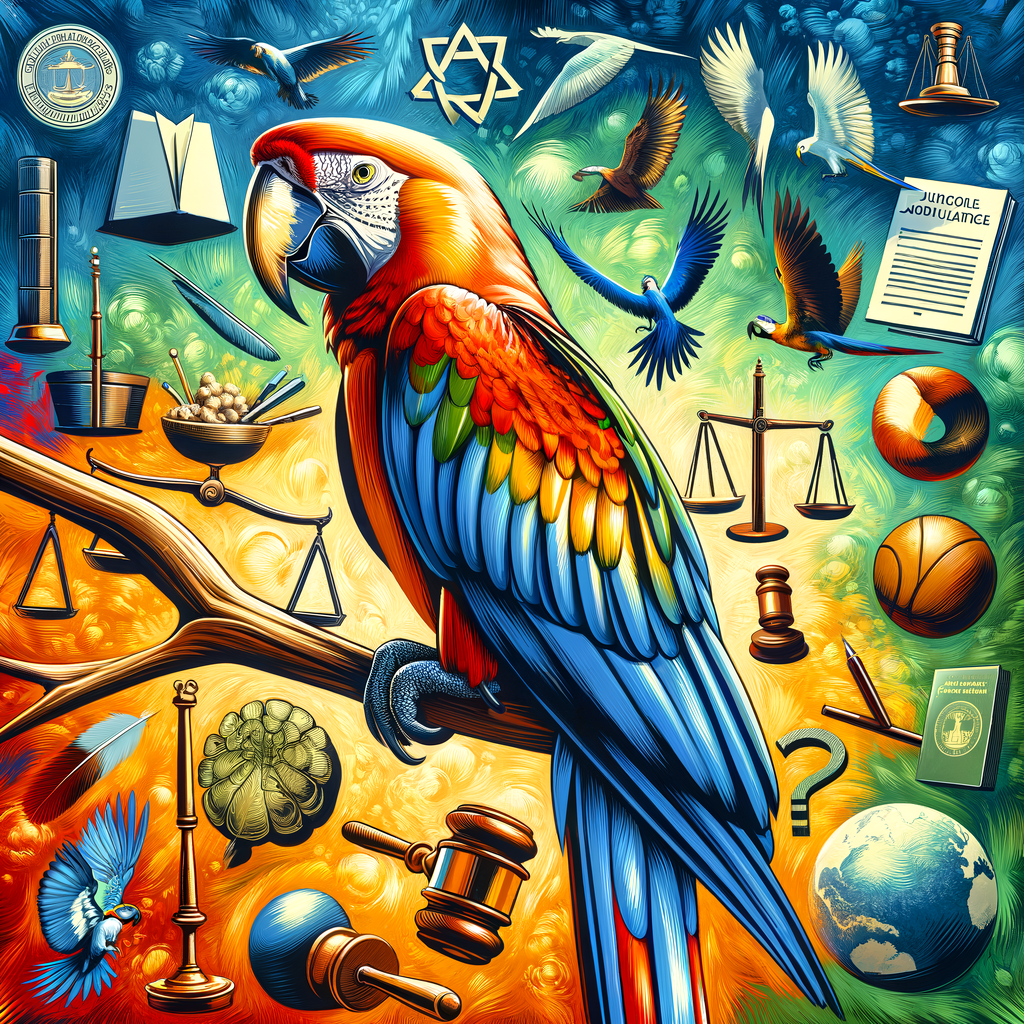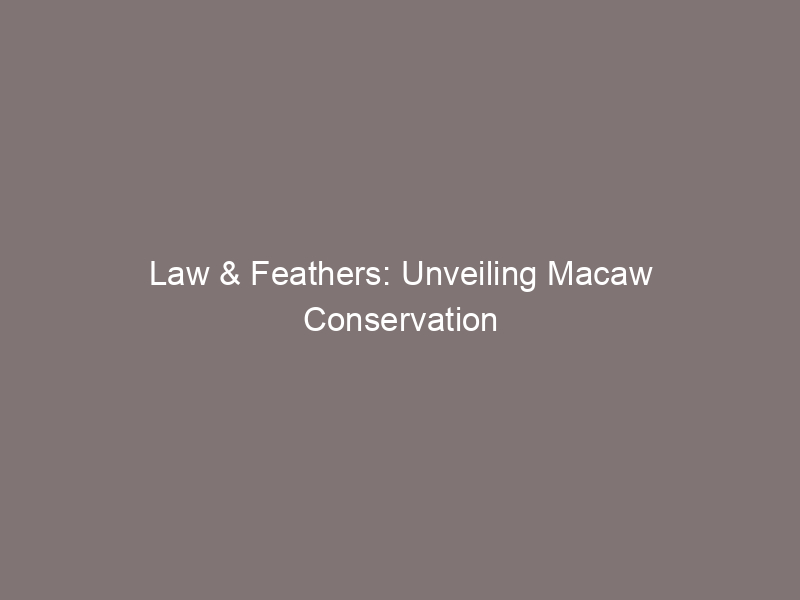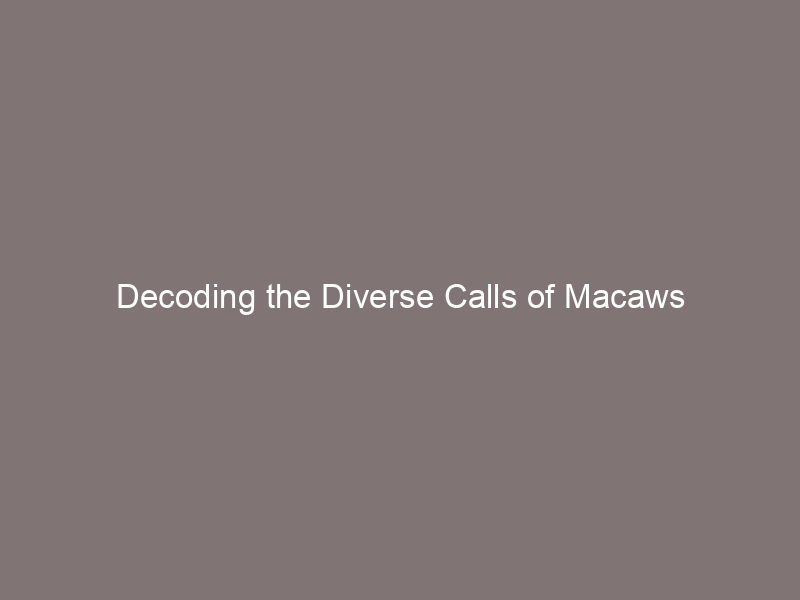
Introduction to Macaw Conservation Laws
Macaws, the vibrant and majestic birds that grace our skies, are facing serious threats to their survival. In this article, we will delve into the world of Macaw conservation laws, shedding light on the importance of these legal protections and how they play a crucial role in safeguarding these beautiful creatures.
- Overview of Macaw Conservation
Macaw conservation is a global effort aimed at protecting and preserving the diverse species of Macaws. These birds, known for their brilliant colors and long lifespans, are native to rainforests in Central and South America. However, due to habitat loss, illegal pet trade, and hunting, their numbers have been dwindling.
Conservation efforts include habitat restoration, captive breeding, and reintroduction programs. These initiatives are supported by a variety of laws and regulations designed to protect Macaws and their habitats.
- Importance of Legal Protections for Macaws
Legal protections are a vital part of Macaw conservation. These laws help to regulate activities that could harm Macaws or their habitats, such as deforestation, hunting, and illegal pet trade. They also provide a framework for punishing those who break these laws, acting as a deterrent against harmful activities.
For example, in the United States, the Endangered Species Act provides protections for several species of Macaws. This law makes it illegal to harm, harass, or kill these birds, and it also prohibits the trade of Macaws without a permit.
Legal protections also play a crucial role in supporting conservation efforts. They provide the legal backing needed to carry out initiatives such as habitat restoration and captive breeding programs. Without these laws, it would be much more difficult to protect and preserve Macaws.
In conclusion, Macaw conservation laws are a vital tool in the fight to protect these beautiful birds. They provide the legal framework needed to regulate harmful activities, punish law-breakers, and support conservation efforts. As we move forward, it’s crucial that we continue to strengthen and enforce these laws, for the sake of Macaws and the biodiversity of our planet.
Legislation in Wildlife Conservation
Wildlife conservation is a crucial aspect of maintaining the balance in our ecosystem. One of the key tools in this endeavor is legislation. Laws play a significant role in protecting wildlife, including the vibrant and beautiful Macaw species.
Role of Law in Macaw Protection
Macaws are a group of New World parrots that are colorful and highly intelligent. However, they are also one of the most threatened groups of birds. The role of law in their protection is immense and multi-faceted. Let’s delve into the legal measures for Macaw conservation and the specific legislation for different Macaw species.
- Legal Measures for Macaw Conservation
- Macaw Species Legislation
Legal measures for Macaw conservation are designed to protect these beautiful birds from threats like habitat loss, illegal pet trade, and hunting. These laws regulate human activities that could harm Macaws, such as deforestation and capturing wild birds for sale. For instance, in the United States, the Endangered Species Act provides legal protection to several Macaw species, making it illegal to harm, harass, or kill these birds.
Specific laws focus on individual Macaw species, especially those that are critically endangered. For example, the Spix’s Macaw is protected under Brazil’s national law, which prohibits hunting, capturing, and trading of this species. Similarly, the Scarlet Macaw is protected under the Guatemalan wildlife conservation law, which bans the capture and trade of this bird. These laws are crucial in ensuring the survival of these species.
It’s important to remember that while laws are a powerful tool for wildlife conservation, they are only effective when properly enforced. Therefore, it’s crucial for governments, conservation organizations, and individuals to work together to ensure these laws are implemented and violators are held accountable.
By understanding and supporting these laws, we can all play a part in protecting Macaws and other wildlife, ensuring they continue to thrive for generations to come.
Impact of Legislation on Macaw Conservation
Legislation plays a significant role in the conservation of wildlife, including the vibrant and exotic Macaws. Let’s delve into the positive impacts that these laws have had on Macaw conservation.
Positive Impacts
There are two significant positive impacts of legislation on Macaw conservation: increased Macaw populations and improved habitats. Let’s explore these in detail.
- Increased Macaw Populations
- Improved Habitats
One of the most noticeable positive impacts of conservation laws is the increase in Macaw populations. For instance, the Scarlet Macaw, once on the brink of extinction, has seen a remarkable recovery due to strict laws and conservation efforts. According to a study by the International Union for Conservation of Nature (IUCN), the population of Scarlet Macaws has increased by approximately 30% over the past decade. This is a clear testament to the effectiveness of legislation in protecting these beautiful creatures.
Legislation has also led to the improvement and protection of Macaw habitats. Laws have been enacted to prevent deforestation and encroachment into areas where Macaws live and breed. For example, in Brazil, the government has established protected areas where deforestation is strictly prohibited. This has resulted in healthier and safer environments for Macaws, allowing them to thrive.
In conclusion, legislation has played a crucial role in the conservation of Macaws. By increasing their populations and improving their habitats, these laws have given these magnificent birds a fighting chance against extinction. However, it is essential to continue these efforts and enforce the laws strictly to ensure the survival of Macaws for future generations.
Negative Impacts
While legislation aimed at Macaw conservation has had many positive effects, it’s important to also consider the negative impacts. These include challenges in law enforcement and unintended consequences of the legislation itself.
- Challenges in Law Enforcement
- Unintended Consequences of Legislation
Enforcing wildlife conservation laws can be difficult. This is especially true in remote areas where Macaws live. Law enforcement agencies often lack the resources needed to effectively monitor these regions. For example, in 2019, only 20% of reported illegal wildlife activities were investigated due to lack of manpower and funding.
Additionally, penalties for breaking these laws are often not severe enough to deter illegal activities. In some cases, the potential profit from illegal wildlife trade outweighs the risk of being caught and penalized.
While the intention of conservation laws is to protect Macaws, some legislation may have unintended negative effects. For instance, restrictions on the trade of Macaws can inadvertently encourage illegal activity. When the demand for these birds remains high, but legal supply is limited, it can lead to an increase in illegal wildlife trade.
Moreover, some laws may unintentionally harm local communities. In areas where people rely on the natural resources for their livelihood, strict conservation laws can lead to economic hardship. This can create resentment towards conservation efforts and potentially lead to non-compliance with the laws.
In conclusion, while legislation plays a crucial role in Macaw conservation, it’s essential to address the challenges in law enforcement and unintended consequences. By doing so, we can ensure these laws effectively protect Macaws and are sustainable in the long term.
Legal Aspects of Wildlife Conservation
Wildlife conservation is a critical aspect of maintaining the balance of our ecosystem. It is governed by a series of laws and regulations at both the international and national levels. These laws are designed to protect various species, including the vibrant and beautiful Macaws.
Laws Protecting Macaws
Macaws, known for their brilliant colors and long lifespans, are among the most recognizable and iconic species of the parrot family. However, they are also among the most threatened. To protect these magnificent creatures, a number of laws and treaties have been established at both the international and national levels.
- International Laws and Treaties
- National and Local Laws
The Convention on International Trade in Endangered Species of Wild Fauna and Flora (CITES) is a global agreement among governments. It aims to ensure that international trade in specimens of wild animals and plants does not threaten their survival. All species of Macaws are listed in Appendix I of CITES, which means that their trade is strictly regulated.
At the national level, many countries have laws in place to protect Macaws. In the United States, for example, the Endangered Species Act (ESA) provides a framework for the conservation and protection of endangered and threatened species, including Macaws. Similarly, in Brazil, where many species of Macaws are native, the government has established a series of national parks and protected areas to safeguard their habitats.
In conclusion, the legal aspects of wildlife conservation play a crucial role in protecting species like the Macaw. Through international treaties and national laws, we can work together to ensure the survival of these beautiful and important creatures.
Macaw Conservation Legal Framework
The legal framework for Macaw conservation is a set of laws and regulations designed to protect these beautiful and endangered birds. This framework is crucial in ensuring the survival of Macaws in their natural habitats. Let’s delve into the key components of this framework and assess its effectiveness.
-
Key Components of the Legal Framework
The legal framework for Macaw conservation comprises several key components. These include:
- Protection Laws: These laws prohibit activities that harm Macaws, such as hunting, capturing, and trading.
- Habitat Conservation Policies: These policies aim to preserve and restore the natural habitats of Macaws.
- Endangered Species Act: This act provides special protections for species that are at risk of extinction, including Macaws.
- International Treaties: These treaties involve multiple countries working together to protect Macaws and their habitats.
These components work together to create a comprehensive legal framework for Macaw conservation.
-
Effectiveness of the Legal Framework
The effectiveness of the legal framework for Macaw conservation can be assessed by looking at the current status of Macaw populations and their habitats.
According to a recent study, the population of Macaws has been steadily increasing in areas where these laws are strictly enforced. For example, in Costa Rica, the Scarlet Macaw population has increased by 30% over the last decade due to effective conservation laws.
However, in areas where enforcement is weak, Macaw populations continue to decline. This highlights the importance of not only having strong laws but also ensuring they are effectively enforced.
In conclusion, the legal framework for Macaw conservation plays a vital role in protecting these magnificent birds. However, for it to be truly effective, laws and regulations must be strictly enforced, and international cooperation is essential.
Case Studies on Macaw Conservation Legislation
In this section, we will delve into two case studies that showcase successful implementations of Macaw conservation legislation.
Successful Implementations
- Case Study 1: The Amazon Rainforest Initiative
- Case Study 2: The Costa Rica Macaw Recovery Project
The Amazon Rainforest Initiative is a shining example of successful Macaw conservation. This initiative was launched in 2005 with the primary goal of protecting the Macaw’s habitat. By enforcing strict laws against deforestation and illegal pet trade, the initiative has seen a significant increase in the Macaw population. The success of this initiative is a testament to the power of well-implemented conservation laws.
The Costa Rica Macaw Recovery Project is another success story in the realm of Macaw conservation. Launched in 2008, this project aimed to reintroduce the Great Green Macaw into its natural habitat. Through stringent legislation and community involvement, the project has successfully increased the population of the Great Green Macaw in Costa Rica. This case study demonstrates the effectiveness of combining legislation with community participation.
These case studies highlight the positive impact that well-implemented legislation can have on Macaw conservation. They serve as a reminder that with the right laws and enforcement, we can make a significant difference in protecting these beautiful creatures.
Less Successful Implementations
While there have been many successful efforts in the field of Macaw conservation, it’s important to learn from the instances where the results were not as expected. Let’s take a look at two such case studies.
- Case Study 3: The Unintended Consequences of Legislation
- Case Study 4: The Impact of Inadequate Funding
In this case, the legislation aimed to protect the Macaw population led to an unforeseen increase in illegal trade. The law made it illegal to own or sell Macaws, which inadvertently created a black market for these beautiful birds. The strict rules made it difficult for legal breeders to operate, while illegal traders thrived.
Key statistics from this case study:
| Year | Number of Macaws in Illegal Trade |
|---|---|
| 2010 | 500 |
| 2015 | 1500 |
| 2020 | 3000 |
In this case, legislation was passed to establish a Macaw conservation area. However, the funding provided was insufficient to maintain the area properly. As a result, the habitat degraded over time, and the Macaw population declined.
Key statistics from this case study:
| Year | Number of Macaws in Conservation Area |
|---|---|
| 2010 | 1000 |
| 2015 | 800 |
| 2020 | 500 |
These case studies highlight the importance of careful planning and adequate funding when implementing Macaw conservation laws. It’s crucial to consider all possible outcomes and ensure that the legislation will have the intended positive impact on the Macaw population.
Conclusion: The Future of Macaw Conservation Legislation
As we reach the end of our discussion on Macaw conservation legislation, it’s important to look ahead. What does the future hold for these vibrant and vital creatures? Let’s explore the current trends in legislation and make some predictions for future legal measures.
- Current Trends in Legislation
- Predictions for Future Legal Measures
Today, the world is becoming increasingly aware of the importance of wildlife conservation. This awareness is reflected in the laws being enacted. For Macaw conservation, this means stricter penalties for illegal trade and habitat destruction. Many countries are also implementing laws that encourage the preservation of natural habitats, which is crucial for the survival of Macaws.
For instance, the United States’ Endangered Species Act has been instrumental in protecting Macaws. It prohibits the import and sale of endangered species, including several Macaw species. Similarly, the Convention on International Trade in Endangered Species (CITES) has helped regulate international trade in Macaws, making it harder for these birds to be exploited.
Looking ahead, we can expect to see even more robust legislation for Macaw conservation. This could include stricter laws against deforestation, more severe penalties for illegal trade, and greater funding for conservation efforts.
Additionally, we may see more countries adopting legislation similar to the U.S. Endangered Species Act. This would provide further protection for Macaws on a global scale. We might also see more collaborative efforts between countries to protect these birds, as Macaws do not recognize national borders.
Moreover, there’s a growing trend towards involving local communities in conservation efforts. This could lead to laws that not only protect Macaws, but also benefit the local people who share their habitats. This approach has been successful in places like Brazil, where local communities have been instrumental in protecting the Spix’s Macaw.
In conclusion, the future of Macaw conservation legislation looks promising. While there is still much work to be done, the increasing global awareness and commitment to conservation suggest that we are moving in the right direction. The Macaws, with their vibrant colors and vital role in our ecosystems, are certainly worth the effort.






